Noman Ghaffar Awan[i], Muhammad Qasim Idrees[ii], Muhammad Khizer Hayat[iii], Arif Ali Rana[iv], Mahnoor Asif[v]
DOI: 10.36283/pjr.zu.11.2/014
ABSTRACT
Background: Low back pain in athletes is common. Core muscles action and function can be understood by the coordination of upper and lower limbs during sports and other dynamic activities. Plyometric exercises are a mainstream type of activity, most generally used to improve athletic performance.
Objective: The objective of this study was to compare the effects of core stability and plyometric exercises in athletes to improve pain and disability in non-specific low back pain
Study design and sampling technique: Current study was the randomized controlled trial. Simple random sampling technique was used in this study. The participants were divided into Group A and B according to Lottery method.
Setting and participants: 38 subjects were considered for the study and divided into two equal groups of 19 each, randomly. Age of selected subjects ranges from 20-40 years. Data were collected from PSB.
Interventions & data collection tools: Participants of groups A performed core stability exercises and group B did plyometric exercises. Pre-Treatment values of VAS and MODI were calculated.
Results: Parametric and Non-parametric tests were performed. Within group comparison after 4th and 8th week was done by using Friedman ANOVA test and it indicated improved results in both groups. Between groups comparison after 4th and 8th week was made by using Mann-Whitney U Test and it showed significant changes in VAS and MODI scores.
Conclusion: Core stability exercises are more effective than plyometric exercises in athletes to improve pain and disability in non-specific low back pain.
Keywords: Back pain, core stability exercises, supine bridging, plyometric exercises, athletes, functional disability.
Introduction
Nonspecific low back pain can be defined as pain in the lower back area, which is not associated with any common pathology like infection, tumor, osteoporosis, fracture, structural deformity, inflammatory diseases, radicular conditions, or cauda equine syndrome1, 3. It is termed as mechanical pain in the lower back4.
The Core muscles are of the utmost importance in sports medicine5, 6. Core stability exercises help to improve athletic performance and in the generation of power, while the complex athletic activities7. It is a further development of the force, and motion, starting from the nearest to the next segment, in accordance with the “summation of force” principle7, 8. In the competitive exercises and sports, force from the earth is transferred through the muscle of core to the distal segments9.
The most important issue for the athletes after low back pain is to go back to the game and back to their previous level of activity after pain management. However, there is not enough information in the literature on this topic, in order to determine the optimum period of time in order to get back to the game after the treatment10. Adequate core strength helps to maintain sufficient core stabilization11. Athletes, during dynamic and highly loaded movement require maintaining stability12.
Plyometric exercises are a mainstream type of activity, most generally used to upgrade athletic execution13. The Stretch-contraction cycle, which includes the extending of muscles and ligaments of the square following the constriction, is a vital piece of plyometric works out14.
A lot of plyometric exercises, even at low intensity, and a lot of stress on the joints, and the speed of the movement and are not eligible for early rehabilitation. Plyometric exercises are one of the most frequently in the lower limb strength training programs can be defined as a fast, powerful movements, which are related to the pre-stretching of the muscle, and just before he falls15.
Effective core stability program is needed to prevent low back pain and to enhance performance. There is lack of literature support among athletes to compare the effects of core stability and plyometric exercises to improve pain and disability in non-specific low back pain. Furthermore, findings from this study definitely help future sports physiotherapists in prescribing specific and effective exercise plan and it will save energy and time of both therapist and athlete.
Qaseem, Amir, et al. did the study “Noninvasive treatments for acute, sub-acute, and chronic low back pain. The LBP and related disability seems to be getting worse with so much progress in the field of treatment and rehabilitation16.
Neff, Shawn carries out research aimed at the prevention of pain in the lower back. Its results showed that some of the exercises are the best to strengthen the muscles and assist in the prevention of the recurrence of pain in low back. The exercises have been selected on the basis of the specific muscle or muscle group, they were designed to do17.
Szafraniec, Rafał, Janusz Bartkowski, and Adam Kawczyński founded that there is an exercise, and it can be incorporated in the training of novice athletes to prepare for the technically challenging task of the Olympics, the scam and the snatch18.
This helped us in comparing the effects of core stability and plyometric workouts on pain and impairment in non-specific LBP in athletes. Athletes employ core strengthening and plyometric workouts to lessen pain intensity and handicap associated with non-specific LBP19. Here is discovered that one of these two types of therapies was more helpful in treating non-specific LBP in athletes. In a country like Pakistan where sports are an emerging field and health, and performance of athletes is usually neglected so there is a need to find the best option for management of LBP and improving function.
Objective
The objective of this study was to compare the effects of core stability and plyometric exercises in athletes to improve pain and disability in non-specific low back pain
Hypothesis
Null Hypothesis: There is no difference between effects of core stability exercises and plyometric exercises in reducing pain and disability in athletes with non-specific low back pain.
Alternate Hypothesis: There is difference between effects of core stability exercises and plyometric exercises in reducing pain and disability in athletes with non-specific low back pain.
Methodology
The study was randomized controlled trial in which data was collected by 38 professional athletes to compare the effects of core stability and plyometric exercises in athletes to improve pain and disability in non-specific low back pain. The sample was randomly divided into two groups, Group A and Group B by lottery method. Each group contained 19 participants. The duration of study was six months after the approval of synopsis. Participants were included on basis of inclusion and exclusion criteria. Inclusion criteria were based on both genders having age between 20 to 40 years. Diagnosed mechanical low back pain and on MODI scale having mild to moderate impairment up to 40% and with VAS score of mild to moderate pain were included in this study. While according to exclusion criteria athletes who were having any pathology off spine, history of trauma, any abdominal surgery or any prior core experience of core strengthening exercise program were excluded in this study. By 5% level of significance and 95% power the calculated sample size was 38. Each group contains 19 participants. Group A receive core stability exercise program and group B receive plyometric exercise program. Visual analogue scale and Modified Oswestry Disability Index were used as data collection tools.
Data Collection Procedure
Athletes who met the inclusion criteria were included in this study. Informed consents were taken from participants after explaining them about research. It was a single blinded study. Total 38 subjects between ages of 20-40 years were selected. Before applying interventions on day one VAS and MODI were measured. Both groups were advised to complete 5 minutes of warm-up exercises, which included spot jogging, free exercises, and gentle stretches with 15 second hold. For the first week, Group A was required to execute these exercises for 6 reps, and thereafter the reps were raised by 50% until the eighth week. • First week – 6 reps • Second week with 9 reps • Third week – 12 reps • Fourth week – 15 reps with 5-10 sec hold • 18 reps in the fifth week; 21 reps in the sixth week; 24 reps in the seventh week • Week eight – 27 repetitions with a 5-10 second hold
Protocol for Exercise
2-3 minutes rest time was considered with proper stretching in between sets of activity. Athletes were requested to undertake cool down exercises include aerobic workouts and stretching exercises, at end of each day exercise programme. Before beginning the next training session, the subjects were asked if they had any discomfort. Test scores for all groups were measured using the same assessment instruments at the end of a 4- and 8-week core stability training programme. The posttest values of two groups were compared at the end of the study.
Data Analysis Procedure
SPSS software version 25 was used to analyse the data in current study. P = 0.05 was set as statistical significance. P = 0.05 was set as statistical significance. Independents test was used between group analysis. Friedman ANOVA was used to show change of subjective as well as objective measurements over time. Between groups comparison at baseline, after 4th week and 8th week was made by using Mann-Whitney U Test.
Results
During the trial, patients were selected randomly and allocated into two groups. The mean age of participants was 29.47 ± 5.94 years. Parametric and Non-parametric tests were performed. Within group comparison at baseline, after 4th week and 8th week was done by using Friedman ANOVA test and it showed significant results in both groups, p-value 0.000 for both Visual Analog Scale and Modified Owestry Disability Index scores. Between groups comparison at baseline, after 4th week and 8th week was made by using Mann-Whitney U Test and it showed significant changes in Visual Analog Scale and Modified Owestry Disability Index scores.
Shows within group comparison in which Pre, Post 4th week & Post 8th week of MODI among Group A (Recreational) and Group B (Competitive) were mentioned.
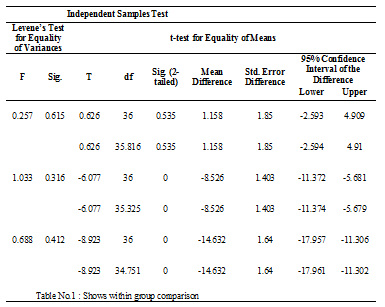
Shows Pair Wise Comparison
Pre-treatment values were taken for both core stability group and for plyometric exercises group. At the end of 4th and 8th week their values were again measured by MODI. Table shows significant results as p-value is (.000).
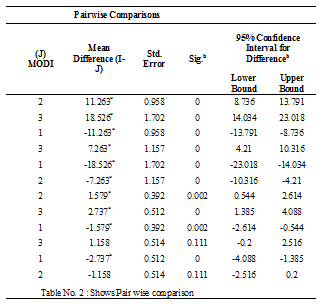
Core stability exercises are more effective as compared to plyometric exercises in reducing pain and improving function but on the other hand it is also visible that plyometric exercises are also effective in pain management and function improvement.
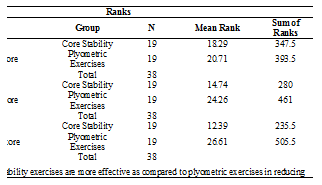
Shows between group comparison in which Pre, Post 4th week & Post 8th week of VAS among Group A (Recreational) and Group B (Competitive) were mentioned. Core stability Mean rank of VAS_PreT_Score is 2.74, VAS_4WT_Score is 2.08 and VAS_PostT_Score is 1.18. Plyometric exercises mean ranks of VAS_PreT_Score 2.42, VAS_4WT_Score is 1.89 and VAS_PostT_Score is 1.68.
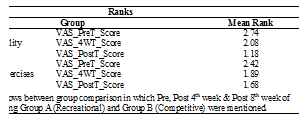
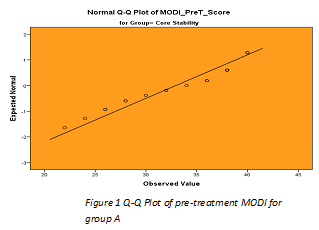
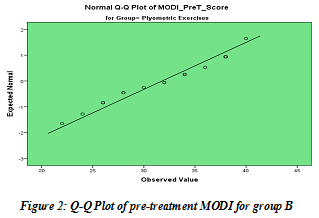
Discussion
According to a systematic review conducted by Stuber et al. the results concluded that core stability exercises were less likely used for the treatment of low back pain which is in contrast to the present study and its result showed that core stability exercises were better for treating low back pain (20). When clinicians assess the athletes for low back pain they falsely assume that athletes have stronger core and implement the dynamic, plyometric exercises which could further leads to worsen the condition. So before implementing plyometric exercises the core should be properly assesse for its strength and deficiencies should be dealt by administering the core strengthening exercises as concluded by a research conducted in 2011 by J Hill and their companions21 and the results of present study also deduced that core strengthening exercises are better than plyometric exercises in the treatment of low back pain in athletes.
Akuthota, Venu, et al. worked on Core stability exercise principles and that is indicated by its vast range of therapeutic applications, core strengthening has a strong theoretical basis in the treatment and prevention of LBP, as well as other musculoskeletal diseases. These programs have been shown in studies to help patients with Alzheimer’s disease reduce discomfort and enhance function. This study elaborated the effects of core strengthening exercises in the management of LBP. Present study concluded that core stability exercises are very effective for pain management and performance improvement22, 23.
A study conducted by Neff, Shawn. Focusing on the Most Effective Exercises for Low Back Pain was also in agreement. It carries out research aimed at the prevention of pain in the lower back. It turned out that some of the exercises that are the best to strengthen the muscles and assist in the prevention of the recurrence of pain in low back17. Another study was conducted focusing on the physiological responses and therapeutic application of plyometric exercise in the rehabilitation of athletes. As a result, plyometric exercise has been suggested as a means of bridging the gap between standard rehabilitative exercises and sport-specific activities24, 25.
A research done in 2017 which was based on 6 week core stability program and results shown core stability exercises are recommended in patients with LBP. The results coincide with this research which shows the same consequences. So while planning the rehabilitation plan, core stability exercises should be incorporated in that plan along with managing the LBP26. A meta-analysis done in 2017 added that core stability exercises are more effective in minimizing pain and increasing functional status of athlete. These exercises should be the basics for athlete with LBP so that this condition does not recur in this population27.
A review discussed the mechanisms associated with plyometric exercises which are consistent with our findings. They concluded that plyometric exercises are very effective for pain management and better performance in sports. The present study reflected that both core strengthening and plyometric exercises are effective in improving pain and disability in non-specific LBP as within group comparison showed via data analysis but core strengthening exercises are more effective for pain management19.
The present study reflected that both core strengthening and plyometric exercises are effective in improving pain and disability in non-specific LBP as within group comparison showed via data analysis but core strengthening exercises are more effective for pain management. There is less literature available regarding plyometric training in treating LBP in athletes. This present research is done to find the best exercise and results showed core stability exercises are more effective in treating LBP, decreasing pain and improving function. In future coaches and sports physiotherapists should include these exercises in training athletes to prevent LBP.
Conclusion
It is concluded that core strengthening exercises are more effective than plyometric exercises in reducing pain and improving functionality of athlete.
Recommendations and Limitations
The main limitation of this study was that it could not investigate the long-term effects of sub occipital muscle energy techniques and neck dynamic stabilization exercises. It is recommended that further studies should be conducted with larger sample size and follow up assessments to ensure the generalizability of the study.
References
- Balagué F, Mannion AF, Pellisé F, Cedraschi C. Non-specific low back pain. The lancet. 2012;379(9814):482-91.
- Moreno Catalá M, Schroll A, Laube G, Arampatzis A. Muscle strength and neuromuscular control in low-back pain: elite athletes versus general population. Frontiers in neuroscience. 2018;12:436.
- Huang L, Liu H, Zhao L, Peng L. The Effect of Exercise Intervention Based Upon the Selective Functional Movement Assessment in an Athlete With Non-specific Low Back Pain: A Case Report and Pilot Study. Frontiers in Psychology. 2020;11:2010.
- Rajan Balakrishnan EY, Mahat MFB. Effectiveness of the core stabilisation exercise on floor and Swiss ball on individual with non-Specific low back pain. International Journal of Physical Education, Sports and Health. 2016;3(1):347-56.
- Kibler WB, Press J, Sciascia A. The role of core stability in athletic function. Sports medicine. 2006;36(3):189-98.
- De Blaiser C, Roosen P, Willems T, De Bleecker C, Vermeulen S, Danneels L, et al. The role of core stability in the development of non-contact acute lower extremity injuries in an athletic population: A prospective study. Physical Therapy in Sport. 2021;47:165-72.
- Srivastav P, Nayak N, Nair S, Sherpa LB, Dsouza D. Swiss ball versus mat exercises for core activation of transverse abdominis in recreational athletes. Journal of Clinical and Diagnostic Research: JCDR. 2016;10(12):YC01.
- Wirth K, Hartmann H, Mickel C, Szilvas E, Keiner M, Sander A. Core stability in athletes: a critical analysis of current guidelines. Sports medicine. 2017;47(3):401-14.
- Saki F, Ramezani F. Comparison of Range of Motion and Strength of Hip Muscles in Female Athletes with and without Dynamic Knee Valgus. Avicenna Journal of Clinical Medicine. 2020;27(2):100-9.
- Bagherian S, Ghasempoor K, Rahnama N, Wikstrom EA. The effect of core stability training on functional movement patterns in college athletes. Journal of sport rehabilitation. 2019;28(5):444-9.
- Cugliari G, Boccia G. Core muscle activation in suspension training exercises. Journal of human kinetics. 2017;56(1):61-71.
- Parveen A, Nuhmani S, Hussain ME, Khan MH. Effect of lumbar stabilization exercises and thoracic mobilization with strengthening exercises on pain level, thoracic kyphosis, and functional disability in chronic low back pain. Journal of Complementary and Integrative Medicine. 2020;1(ahead-of-print).
- Aufar RF, Soegiyanto S, Rustiadi T. Plyometric exercises and concentration levels on the swim-start jump of female athletes in Metro Lampung. Journal of Physical Education and Sports. 2019;8(4):8-14.
- Padulo J, Migliaccio GM, Ardigò LP, Leban B, Cosso M, Samozino P. Lower limb force, velocity, power capabilities during leg press and squat movements. International journal of sports medicine. 2017;38(14):1083-9.
- Kasmi S, Zouhal H, Hammami R, Clark CCT, Hackney AC, Hammami A, et al. The effects of eccentric and plyometric training programs and their combination on stability and the functional performance in the post-ACL-surgical rehabilitation period of elite female athletes. Frontiers in Physiology. 2021;12:954.
- Qaseem A, Wilt TJ, McLean RM, Forciea MA. Noninvasive treatments for acute, subacute, and chronic low back pain: a clinical practice guideline from the American College of Physicians. Annals of internal medicine. 2017;166(7):514-30.
- Neff S. The Most Effective Exercises for Low Back Pain: A Literature Review. Journal of the International Academy of Neuromusculoskeletal Medicine. 2020;17(1).
- Szafraniec R, Bartkowski J, Kawczyński A. Effects of Short-Term Core Stability Training on Dynamic Balance and Trunk Muscle Endurance in Novice Olympic Weightlifters. Journal of Human Kinetics. 2020;74:43.
- Dharod R, Shetty T, Shete R, Mullerpatan R. Effect of Plyometric Training on Explosive Power, Agility, Balance, and Aerobic Performance of Young Adult Male Kabaddi Players. Critical Reviews™ in Physical and Rehabilitation Medicine. 2020;32(3).
- Stuber KJ, Bruno P, Sajko S, Hayden JA. Core stability exercises for low back pain in athletes: a systematic review of the literature. Clinical Journal of Sport Medicine. 2018;24(6):448-56.
- Hill J, Leiszler M. Review and role of plyometrics and core rehabilitation in competitive sport. Current sports medicine reports. 2017;10(6):345-51.
- Akuthota V, Ferreiro A, Moore T, Fredericson M. Core stability exercise principles. Current sports medicine reports. 2018;7(1):39-44.
- Garrido-Ardila EM, González-López-Arza MV, Jiménez-Palomares M, García-Nogales A, Rodríguez-Mansilla J. Effectiveness of acupuncture vs. core stability training in balance and functional capacity of women with fibromyalgia: A randomized controlled trial. Clinical rehabilitation. 2020;34(5):630-45.
- Chmielewski TL, Myer GD, Kauffman D, Tillman SM. Plyometric exercise in the rehabilitation of athletes: physiological responses and clinical application. Journal of Orthopaedic & Sports Physical Therapy. 2016;36(5):308-19.
- AlAteeq DA, Aljhani S, AlEesa D. Perceived stress among students in virtual classrooms during the COVID-19 outbreak in KSA. Journal of Taibah University Medical Sciences. 2020.
- Yalfani A, Ahmadnezhad L, Gholami Borujeni B, Khoshnamvand Z. The Effect of six weeks core stability exercise training on balance, pain and function in women with chronic low back pain. Journal of Health and Care. 2017;18(4):336-46.
- Coulombe BJ, Games KE, Neil ER, Eberman LE. Core stability exercise versus general exercise for chronic low back pain. Journal of athletic training. 2017;52(1):71-2.
The Ziauddin University is on the list of I4OA (https://i4oa.org/) & I4OC (https://i4oc.org/).
![]() This is an open-access article distributed under the terms of the Creative Commons Attribution License (CC BY 4.0). https://creativecommons.org/licenses/by/4.0/
This is an open-access article distributed under the terms of the Creative Commons Attribution License (CC BY 4.0). https://creativecommons.org/licenses/by/4.0/
Conflict of Interest: The author (s) have no conflict.
[i] Lecturer Central Park Medical College
ORCID ID: 0000-0001-7078-4128
[ii] Assistant Professor Central Park Medical College, Lahore
ORCID ID: 0000-0002-3127-1220
[iii] Assistant Professor Bakhtawar Amin Medical College
ORCID ID: 0000-0002-8040-9791
[iv] Assistant Professor Central Park Medical College, Lahore
ORCID ID: 0000-0003-4681-5750
[v] Physiotherapist Rex Medical Centre Lahore
ORCID ID: 0000-0002-6660-6991
